DC is ranked, again, as having the top park system in the US. That’s still a problem.
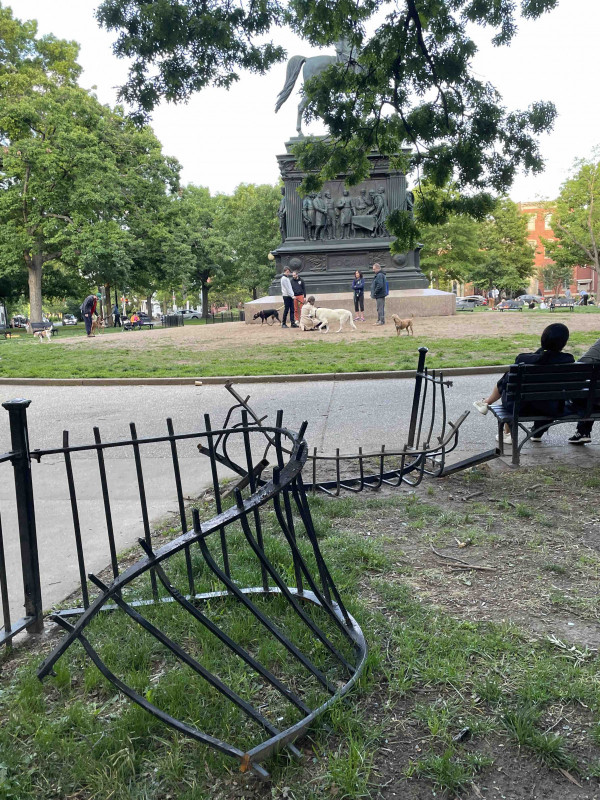
A distorted fence at Logan Circle. From the Neighborhood Park Service report.
This post first ran in May 2023, when DC last received the top rank for parks among cities throughout the US. For the same reasons as last year, this award is frustratingly out of step with many DC residents’ everyday experiences of national parks in particular. Find out why, and what can be done about it.
On paper, the District of Columbia has a nationally renowned park system, last week receiving top ranking from the Trust for Public Land for the third year in a row. On the ground, the fact that 90% of the park system in DC remains under National Park Service control creates major problems for park access, equity, and accountability.
For hundreds of thousands of local residents, many of whom cherish DC’s abundant greenspace, but are just as likely to associate the park system with broken benches, inoperable fountains, and trash, the Trust for Public Land’s award is both perplexing and frustrating. Perplexing because the accolade is practically irrelevant for parks beyond the National Mall, and frustrating because such ranking systems mask the deep problems with the local park system—systemic issues such as infrastructure that is hostile to pedestrians and other non-motorized users and parklands (particularly east of the Anacostia River) that are unidentifiable as parks due to lack of signage, amenities, and ways to use them.
In early May, our team at the Sumner M. Redstone Global Center for Prevention and Wellness published a report outlining the issues associated with these mixed-blessing amenities, and recommending a path to move us forward.
McPherson Square Park, the site of mass displacement of residents experiencing homelessness for the purpose of returfing and site maintenance (it should be noted that the site is still fenced-off and the tulips pictured have since died). Image by Kelly Whittier 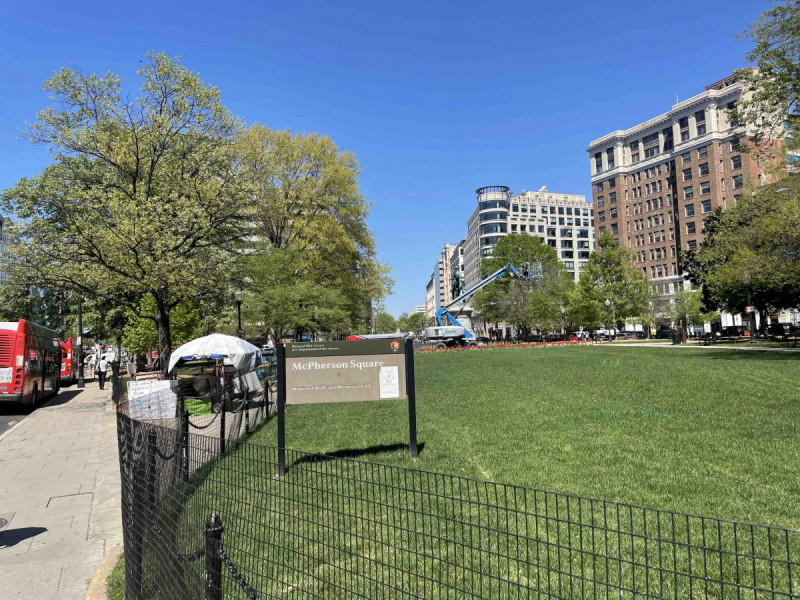
Parks are an untapped public health resource
A wealth of research shows that parks directly benefit individual and community health. Parks provide opportunities for physical activity, stress reduction, and socialization in addition to contributing economic benefits for local communities. They’re among our most underappreciated climate assets, via stormwater management, better air quality, wildlife habitat, and cooling effects.
The catch is that these significant benefits can only be realized when public space is accessible, inviting, and meets the demands of the surrounding community. With parks that are inconsistently managed and inequitably maintained, the District is not even close to fully realizing these benefits.
Rancid pooling water in the long-inactive fountain at Malcolm X/Meridian Hill Park. Image by Kelly Whittier _1_800_532_90.JPG)
Why other places can invest in their neighborhood parks and DC can’t
The District faces a unique barrier when trying to improve its park system: unlike other major cities, it does not own most of its parkland. Most residents are aware that the National Park Service (NPS) has a significant presence in the region, with the National Mall and Rock Creek Park being among its most prominent sites, but many do not realize the full extent of NPS’s presence.
NPS controls over 350 individual tracts of land in the District totaling 6,500 acres, or nearly 90% of the public park system. Some of these parks have national or historic significance, but many of them do not. Over two-thirds of NPS’s parks are under 1 acre in size and many contain no amenities. Not even a park bench. In extreme cases, ambiguities over NPS vs. local ownership has allowed adjacent homeowners to physically take over space that communities see as public parks, installing hedges and other mechanisms to hoard public spaces for private use.
Meanwhile, the DC Department of Parks and Recreation (DPR) controls only 851 acres. As a result of NPS’s dominance, DPR has evolved into an agency heavily focused on recreational programming and facilities, with parks constituting only a very small part of its portfolio.
A roped-off downtown pocket park along Pennsylvania Avenue NW. Image by Kelly Whittier 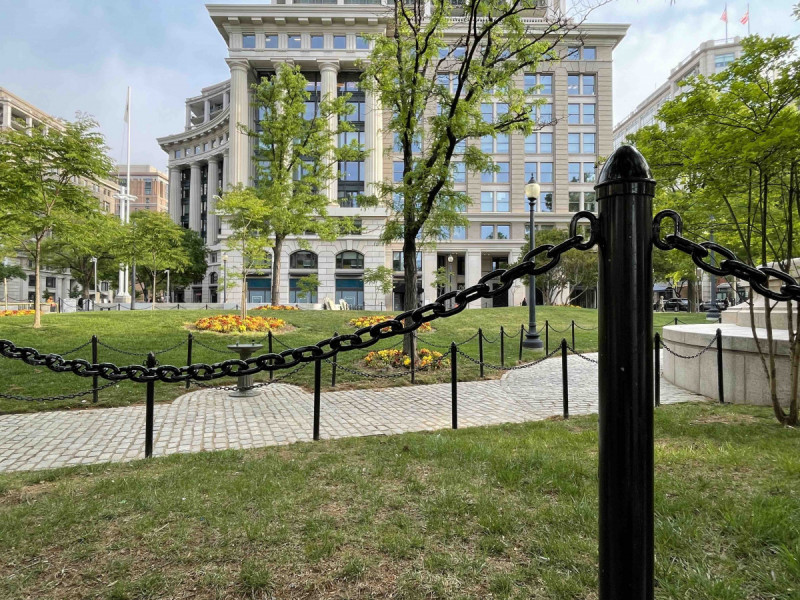
Here’s what’s holding us back
Recognizing NPS’s outsized control of the park system, and the implications for health and the environment, I led a research team in a yearlong study exploring how NPS’s ownership affects the District’s ability to create an equitable and activated park system. In our research, we interviewed dozens of local residents, government staff, elected officials, and organizations about their experience trying to utilize or improve local greenspace. Our research identified several key challenges that are created due to the entangled jurisdiction of the park system:
Mission Conflict: NPS’s historic and cultural preservation model is appropriate when applied to historic sites and wilderness protection, but it is a poor fit in dynamic urban environments where federal parklands are woven into residential neighborhoods. Because NPS is charged with preserving spaces, not activating them, its priorities often conflict with the needs of District residents. Communities need access to playgrounds, dog parks, programming, and other amenities in its urban parks that are nearly impossible to realize under NPS’s management model.
Jurisdictional Confusion: Control of the District’s greenspace is divided between NPS, several District agencies, other federal agencies, and private entities. These boundaries are often unclear, which creates jurisdictional confusion for residents and policymakers alike. When residents have an issue with their local park, they often do not know who manages it, and do not know how to contact the correct entity. In addition, NPS’s DC parks are divided among six different administrative units, each with their own policies and priorities, which further confuses residents and impedes progress on the overall park system.
Funding Constraints: NPS’s famously limited funding is a major challenge that undermines efforts to improve park resources. The agency simply does not have adequate funding to manage its assets in DC. With billions of dollars in deferred maintenance costs and the lion’s share of funding being concentrated downtown, funding gaps inhibit NPS’s efforts to maintain and improve existing infrastructure across the District. Local “Friends Of” groups often pick up the tab for these needs, but the dependency on community groups exacerbates inequities across the park system as parks in better-resourced neighborhoods are more able to access supplemental funding through fundraising and community support. As a direct result, the large NPS parks in Wards 7 and 8 (of which there are many) face persistent disinvestment and neglect.
Vision & Coordination: Because the District and NPS share control over the District’s parks, there is no central leadership and vision for the overall park system, meaning that the District lacks the #1 component of an effective park system: “a clear expression of purpose.” The District already invests significant local dollars into NPS land, through stream restorations, park improvements, and remediation, as well as the recent $21 million renovation of Franklin Park. But despite the overlapping jurisdiction, there is no structure in place for regular coordination between NPS and the District regarding parks management. In instances when NPS and the District do coordinate, the process is burdensome and time consuming.
Accountability & Communication: NPS is a federal agency that does not answer to the District’s elected officials or voters. It does not proactively engage with the community, so residents find it difficult to communicate with the agency about issues they see in NPS-managed parks. The agency is not integrated into the District’s 311 system, and is not responsive to inquiries and requests from residents.
Policies & Procedures: NPS procedures make it very difficult for communities to pursue active use of their spaces. NPS’s permitting process is lengthy and arduous, and its partnership agreements, designed to facilitate collaboration, are also burdensome. These procedures make it difficult for community organizations and the District government to partner with the agency to provide programming on NPS land, and pose a particular barrier to communities that lack the resources to sustain a philanthropic partnership. In addition, NPS policies, such as prohibitions on concessions or lighting after dark, often prevent the types of programming that residents would like to see implemented in their parks.
Together, these challenges have hindered efforts to create an equitable, well-integrated, and activated park system that promotes health for all District residents.
An overgrown and neglected pocket park abutting Grant Circle. Image by Kelly Whittier 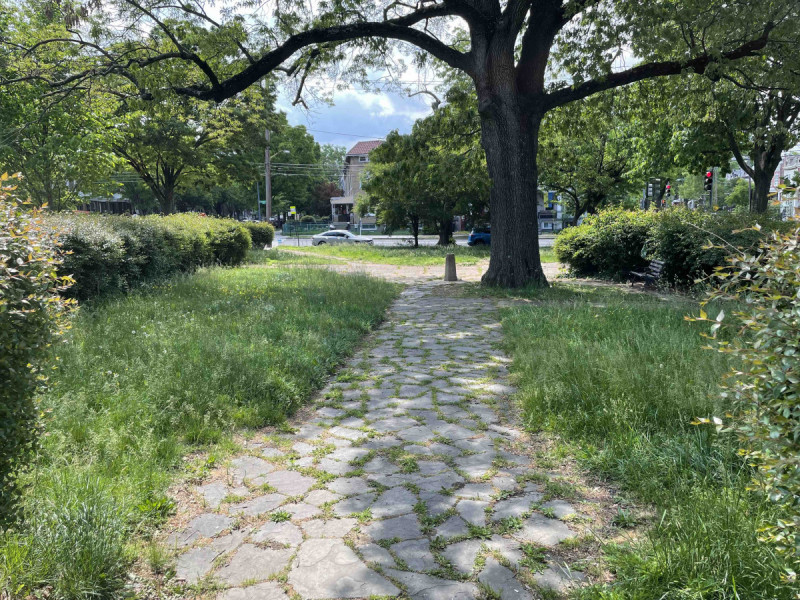
But there’s hope…
As with any circumstance dealing with complex bureaucracies and ingrained practices, it is tempting to look at a situation like this and think, it’s too entrenched, there’s nothing we can do. But our research found that there is significant opportunity to improve the park system and our Neighborhood Park Service report details several policy recommendations for how the District of Columbia government, National Park Service, and Congress can improve management of the park system.
Our top recommendation for the District is that DPR establish an office specifically focused on building its parks management capacity and managing the District’s interests in NPS land. This office would address the need for consistent staff resources to be dedicated toward the relationship between the District and NPS, including identifying areas of collaboration, tracking ongoing projects on behalf of the District and the public, and managing cooperative management agreements (CMAs), such as was arranged at Franklin Park, and transfers of jurisdiction (TOJs), which give the District management authority over a park.
Along with the investments at DPR, we recommend that the District establish a Parks Advisory Board, building on the success of the Capital Trails Coalition, to serve as a coordinating body and to provide long-term direction for the District’s park system. This entity should meet regularly to share information about ongoing projects and to identify opportunities for collaboration. Using these new resources, the District and NPS should work together to prepare a joint action plan specifically focused on future management of NPS land and identify sites that would be appropriate for TOJs and CMAs. The District and NPS should also work together to create a shared database to consolidate and synchronize information on federal and local parks and open spaces, and to develop a coordinated approach to service requests and permitting needs–including integrating NPS into the District’s 311 system.
Oxon Run Park. One of the park areas DC has already committed to doing restoration for in Ward 7 and Ward 8. Image by District Department of Energy and the Environment. 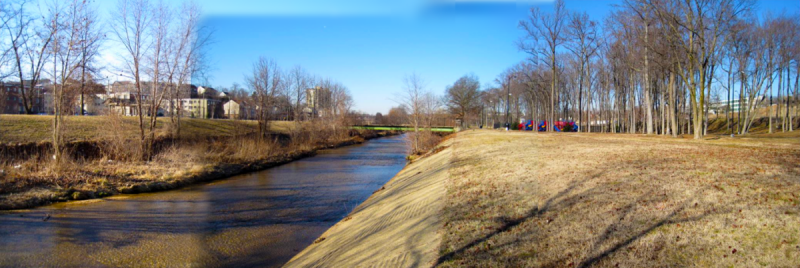
…And now is the time to act
This report is essentially the first of its kind to capture the longstanding frustrations and challenges that residents experience with the DC park system. Just days after its release, dozens of ANC Commissioners rallied behind the central tenet of the report: that in order to create a cohesive park system that serves the needs of local residents, the District must take control of more neighborhood parks.
We can no longer hide behind flattering headlines and top national rankings. It is time to acknowledge these issues and work towards a more activated, equitable, and health-centered park system, for everyone.
